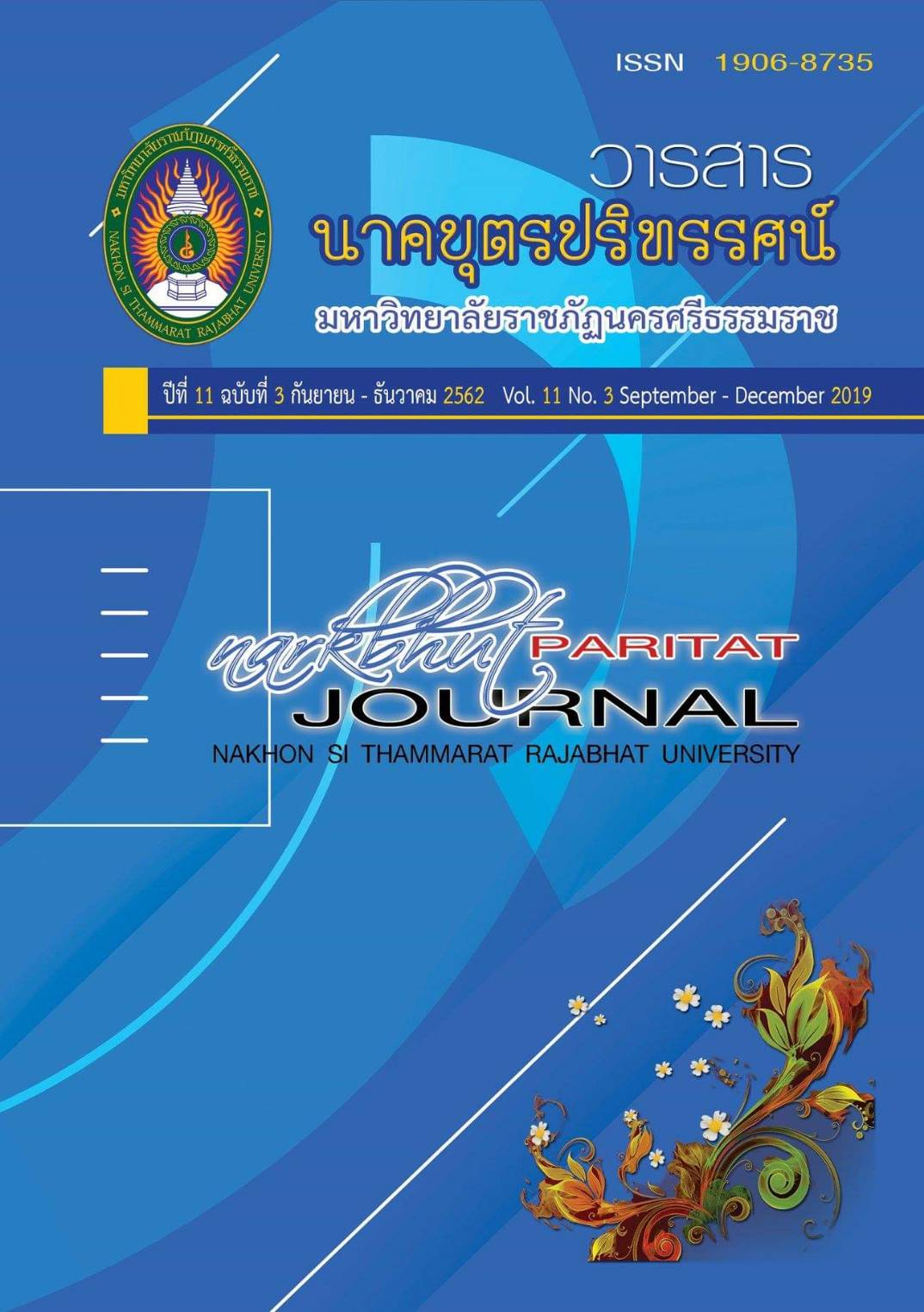เครือข่ายความเข้มแข็งด้านการใช้ภาษาและวัฒนธรรมไทยทรงดำในจังหวัดสุราษฎร์ธานี Strength network of Ianguage usage and Tha Dong Dami culture in Suratthani province
Main Article Content
Abstract
การวิจัยครั้งนี้มีวัตถุประสงค์เพื่อศึกษาพัฒนาการของกระบวนการสร้างเครือข่ายกลยุทธ์การจัดการเครือข่าย และรูปแบบการสร้างเครือข่ายความเข้มแข็งด้านการใช้ภาษาและวัฒนธรรมไทยทรงดำในจังหวัดสุราษฎร์ธานีโดยอาศัยการการวิจัยเชิงคุณภาพในการเก็บรวบรวมข้อมูลจากการสัมภาษณ์ การสังเกตการณ์ ได้แก่ ครูภูมิปัญญาและชาวไทยทรงดำในชุมชน หน่วยงานภายนอก ผู้นำชุมชน อาจารย์ นักวิชาการ ร่วมกับการศึกษาเอกสารทางวิชาการ ตำรา และงานวิจัยที่เกี่ยวข้อง
ผลการศึกษา พบว่า พัฒนาการของกระบวนการสร้างเครือข่ายมีทั้งส่วนที่ปรับตัวและส่วนที่ถูกคัดเลือกไว้ โดยเฉพาะพิธีกรรมเกี่ยวกับความเชื่อเรื่องผีแถนหรือผีบรรพบุรุษ ผ่านพิธีศพและพิธีเสนเรือน ทำให้ชุดเสื้อฮี ยังคงทำหน้าที่แสดงถึงความกตัญญูแก่บรรพบุรุษที่ล่วงลับไปแล้ว ในขณะที่การแต่งกายในชีวิตประจำวันถูกลดทอนลงเนื่องจากปัจจัยการผลิตที่ไม่เอื้อต่อการตัดเย็บ และมีการเผยแพร่วัฒนธรรมออกสู่ภายนอก เช่น งานแสดงเปิดงานในจังหวัด รายการโทรทัศน์ สถาบันการศึกษาและงานแสดงโชว์ต่างประเทศ เป็นต้น สำหรับกลยุทธ์การจัดการเครือข่าย ประกอบด้วย 5 ประการ คือ ประการแรก กลยุทธ์เชื่อมร้อยความรู้สึกร่วมกันผ่านทางการแต่งกาย และการประกอบพิธีกรรม ประการที่สอง กลยุทธ์การรักษาและขยายอัตลักษณ์ของชุมชน เช่น การแต่งกายประกอบการแสดงรำในชุดไทยดำรำพัน และการนำลวดลายผ้าทำเป็นสินค้าทางวัฒนธรรม ประการที่สาม กลยุทธ์สืบทอดความเชื่อผ่านเสื้อฮี ประการที่สี่ กลยุทธ์การบริหารจัดการเครือข่าย ประกอบด้วย ความยืดหยุ่น ความเสมอภาค ความเป็นอิสระ และการมีเป้าหมายที่ชัดเจน และประการสุดท้าย กลยุทธ์การสร้างรายได้ ด้วยการนำลวดลายผ้ามาทำเป็นสินค้าทางวัฒนธรรม เช่น กระเป๋า พวงกุญแจ ซองใส่มือถือ ลายหน้าหมอน เป็นต้น สำหรับรูปแบบการใช้ภาษาและวัฒนธรรมไทยทรงดำ สามารถจำแนกได้ เช่น การใช้ภาษามีการบรรจุเข้าเป็นส่วนหนึ่งในการเรียนการสอนเข้าสู่โรงเรียนบ้านไทรงาม และเป็นการสร้างการเรือนรู้ให้กับองค์กรภายนอก เช่น มหาวิทยาลัยราชภัฏสุราษฎร์ธานี พิธีศพ พิธีแปงขวัญ พิธีเสนเรือน และการแต่งกายเข้าร่วมกิจกรรรมของโรงเรียน สำนักวัฒนธรรมจังหวัด วัดและงานเทศกาลวันสงกรานต์ ชาวไทยทรงดำได้ร่วมกันแต่งกายเพื่อสร้างสายสัมพันธ์ทางสังคมระหว่างชาวไทยทรงดำร่วมกัน
The research purposes were to study the development of network building procedures, the network management strategies, and the formats for building strength network in terms of language use and culture of Thai Songdam in Surat Thani. The qualitative research was used to collect the data namely the interview and the observation which were collected from wisdom teachers and Thai Songdam people in the community, organizations, community leaders, lecturers, academic scholars, as well as the review study from academic documents, textbooks, and related researches. The result revealed that there were both adaptive and selective parts of the development of network building procedures especially the belief about the ritual of Phee Than (Ancestral spirits) called the funeral ritual and Sen Ruen ritual. Accordingly, dressing ‘Hee’ represented the respect of dead ancestors. However, its dressing in daily life was diminished due to the production factors which were not kind for dressmaking. It was culturally seen in public such as provincial performances for opening ceremony, T.V. programs, educational institutes, and international performances. According to the network management strategies, there were 5 strategies namely the strategy of feeling sharing through dressing and ritual-making, the strategy of perseverance and broadening the community identities such as dressing Thaidam Ramphan in shows, clothing patterns in cultural products, the strategy of belief inheritance through ‘Hee’ dress, the strategy of network management such as flexibility, equality, liberty, and clear target, and the strategy of earning such as the application of clothing patterns in cultural products of bags, keychains, cell phone cases, and pillow cases. According to the formats of the language use and culture of Thai Songdam, it could be classified as following; the language use has been a part of teaching and learning at Ban Sai-Ngam school; it enhanced learning for outside organizations such as Suratthani Rajabhat University; it was in the funeral ritual, Pang Kwan ritual, Sen Ruen ritual, and dressing in school activities, the provincial cultural office, temples and Songkran festival. In addition, Thai Songdam gathered wearing their cultural dress in order to build their social relationships.
Article Details
References
Collection of Subject Philosophy, Communication Arts and Communication Theory (Unit 8-15). Nonthaburi. (In Thai)
Iawasriwong, N., Waliphodom, S. & Na Thalang, E. (1995). Looking at the future: an analysis to
change the direction of Thai society. (4th ed). Bangkok: Amarin Printing and Publishing
Company Limited. (In Thai)
Kaewthep, K. (2006). Under the sky of education, personal media and communication networks.
Bangkok: The Thailand Research Fund. (In Thai)
Kettet, B. (1976). Thai Song Dam ethnic group. Bangkok: Odeon Store. (In Thai)
Kingkham, W. (2004). Locale. Bangkok: Kasetsart University Document and Text Center. (In Thai)
Natsupha, C. and Lertwicharn, P. (1998). Thai Village Culture. Bangkok: October printing. (In Thai)
Phongphaibun, S. (2001). Structure and Dynamic of Southern Culture and Development. Bangkok:
The Thailand Research Fund. (In Thai)
Phongphaibun, S. (2004). Culture. Bangkok: Heart Health. (In Thai)
Srisuchat, A. (2001). Ethnic groups (2nd ed). Bangkok: Amarin Printing and Publishing. (In Thai)
Vejviroj, S. (2009). Identity communication and dressing of Thai Song people in Phunphin District,
Changwat. Surat Thani. Master of Journalism Thesis Faculty of Journalism and Mass
Communication Thammasat University. (In Thai)
Wasasi, P. (1998). Cultural investment. In the vision of a cultural expert. (Nor 45-55). Bangkok:
Religious Printing House. (In Thai)
Wasasi, P. (2004). Development must rely on culture. Bangkok: Ministry of Culture. (In Thai)

